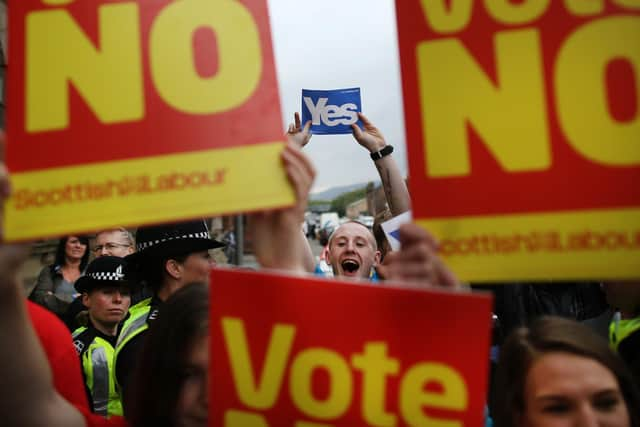Scottish independence: Unionists need to make the emotional case for staying in the UK – John McLellan
Charged with assembling an independent panel to produce a question for the 2014 referendum, I approached the late Lord Sutherland to chair it, but finding others to join him was less straightforward. Mr Qvartrup was an obvious choice, so obvious that we learnt the SNP had approached him too, an offer he declined. Our group was completed by the Canadian electoral officer Ron Gould who had experience of the Quebec independence votes and 80 other elections in 50 countries.
The panel concluded the question should be a straight yes/no to the statement that "Scotland should be an independent state", almost exactly what the Electoral Commission subsequently approved, much to the dismay of some unionist commentators. But they might have been less concerned had not problems with his flight prevented Mr Qvartrup from attending Lord Sutherland’s press conference to present the findings, because when he eventually made it to Edinburgh after the presentation was over, he was sporting Union Flag cufflinks.
Advertisement
Hide AdAdvertisement
Hide AdMr Qvartrup is back in Scotland tomorrow, for an event at Glasgow University to promote his new book I Want to Break Free: A Practical Guide to Making a New Country, and judging by an interview he gave to The Herald newspaper it’s hard to know if his tongue is still in his cheek. “The more Scots can be made to see themselves as victims of English imperial nationalism the better,” he said. “The SNP should say ‘we’ve always been treated like a fiefdom’, but we’ve social democratic values like Scandinavia. A ‘please release me’ type of thing.”


I’m sure he’s been busy in the eight years since the 2014 referendum, but whether you agree with it or not, there can be no denying this is precisely the approach the SNP has been taking, particularly since the 2016 EU vote. Getting governments Scotland doesn’t vote for, dragged out the EU against our will, Tory cost-of-living crisis, we can all be Danes, and the rest of it have been constant themes, and when he says the independence campaign “needs to be more sloganistic”, he mustn’t have been listening. Similarly, his call for the independence movement to embrace the symbolism of nationhood is as if the ‘All Under One Banner’ movement, with its saltires, bagpipes and feathered bonnets, doesn’t exist.
Scotland isn’t short of national symbols which both sides of the argument sport proudly, and the weakness of his analysis is precisely because the strong sense of nationhood was preserved in the Act of Union, and actively enhanced in the 19th century, particularly by the publication of Walter Scott’s Waverley in 1814 and the visit of George IV eight years later. The enthusiastic participation of Scots in Empire building is one reason the whole “imperial victimhood” argument remains hard to sustain.
I’ve long thought the Better Together campaign’s insistence on not playing emotive cards and sticking to hard economic facts ceded the emotional high ground to the Yes movement and produced a closer result than might otherwise have been the case. So, if there are lessons in what Mr Qvartrup is saying then they are there for the unionist side to learn, not just separatists. If, as he says, “winning a referendum is about hearts, not minds”, then it’s not something pro-Union arguments can afford to dismiss, even if there will be no referendum any time soon, because as long as the SNP remains a dominant electoral force the potential is always there. And if the result of the next UK general election is inconclusive, then then a second referendum will be on the cards as an SNP bargaining chip.
But the numbers matter, and Brexit and the cost-of-living crisis, particularly the impact of high, uncosted government borrowing on interest and inflation, have changed everything. The impact of upheaval is not just a matter of political theory but of daily lived experience, and the “reprioritisation” of £400m in the Scottish health budget when the £20m set aside for an independence referendum in 2023 has been left intact, despite only 35 per cent of voters wanting one next year, won’t go unnoticed. In fact, the lack of detail in the Scottish Government’s three recent independence papers indicates a retreat from brass tacks argument when that’s exactly what wavering voters demand. Even after two years of debate up to the 2014 vote, the Electoral Commission found that 25 per cent of people didn’t have enough information on what would happen after a No vote, and 28 per cent after a Yes victory, so how the Scottish Government thinks giving less information to avoid awkward questions will help is anyone’s guess.
The new UK Government under Rishi Sunak understands the need for proper engagement in Scotland, starting with the call to First Minister Nicola Sturgeon, and a determination in the Scotland Office to develop the Levelling Up agenda and deepen direct engagement with Scottish local authorities to fund key projects the Scottish Government is either unable or unwilling to support. This week’s squabble over Springburn’s derelict Winter Gardens is a good example of the desire of local campaigners to get their hands on resources no matter the source.
The shape of public spending will be clear after next week’s Autumn statement, both the cash available to the Scottish Government through the block grant and also how the Levelling Up programme will be rolled out. It may be that the Prime Minister can head north soon after to highlight the UK Government’s investment in Scotland, which would be a practical and political demonstration of commitment, but only the start. But with Ms Sturgeon’s administration looking more tired by the day, maybe Mr Qvartrup can look out those Union Flag cufflinks again.
Comments
Want to join the conversation? Please or to comment on this article.
